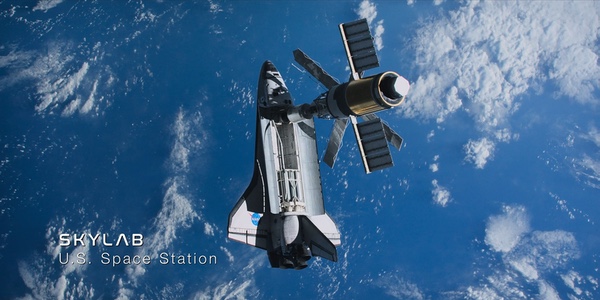Revisiting the past’s future: ongoing ruminations about “For All Mankind”by Emily Carney and Dwayne A. Day
|
| Initially, it’s all machismo. It’s brave men and heroes. But that’s about to change very fast. And that makes the show’s title a bit ironic—it’s not about “man” after the first episode. |
This is when we get to meet Ed Baldwin and Gordo Stevens, who were just mere kilometers from the lunar surface weeks before. At The Outpost, an astronaut hangout modeled on a long-gone bar not far from Johnson Space Center, the astronauts have an insane, alcohol-soaked party, which culminates in a group singalong to Jimmy Ruffin’s “What Becomes of the Brokenhearted?” In my mind, I think this was shown to compare how men coped with defeat and heartbreak versus how women—in the upcoming narrative—would cope with similar stressful situations. Ed Baldwin even briefly kneecapped his own career by opening up about his frustrations with NASA to a reporter. At any rate, by this point, women were wives and mothers in the “For All Mankind” universe, not astronauts or management.
Dwayne:
Yeah, that’s a good observation. Initially, it’s all machismo. It’s brave men and heroes. But that’s about to change very fast. And that makes the show’s title a bit ironic—it’s not about “man” after the first episode.
After the Soviet Union beats America to the Moon, the Americans respond by landing Apollo 11, which in this alternative timeline, nearly ends in failure. But the Soviets then follow up with another significant first when they land a woman on the Moon. We see one of the female characters—a young Mexican girl named Aleida—smile when she sees that a woman is on the Moon.
Emily:
The early Russian space program was seen by some people as more “progressive” because they flew a woman to space in 1963. At the time, Clare Boothe Luce had written an article for LIFE magazine called “She Orbits Over the Sex Barrier” that praised the Soviets for letting women fly, and criticized the US space program for not having women astronauts. But we now know Valentina Tereshkova’s flight was more of a propaganda move than an actual effort to fully integrate women into spaceflight (“See? Even a woman can do it!”).
To this day, only four Russian women have flown in space; to my knowledge, there is only one current woman cosmonaut, who, while having been a member of the corps for some time, hasn’t yet made a spaceflight. Recent cosmonaut candidates are comprised of all men. The Russians are famously superstitious when it comes to having multiple women aboard spacecraft. So, it’s an accurate move by “For All Mankind” to “let” a woman walk on the Moon just to have another world record, because we don’t see another Soviet woman on the Moon throughout season one or season two.
Dwayne:
After launching Valentina Tereshkova in 1963, there was not another female Soviet cosmonaut until Svetlana Savitskaya in 1982. Her two missions (she flew again in 1984 where she was the first woman to perform a spacewalk) were also propaganda stunts. The other women who were training with Tereshkova in the early 1960s all “retired” in 1969.
You mention Clare Booth Luce. I had to look her up. She was a complicated figure. She wrote an all-woman play, was a member of Congress, and was a strident anti-communist. The fact that she praised the Soviet Union for launching Tereshkova is interesting because she was not an admirer of the Soviet Union. But we should also remember that this was an active discussion during the early American space program. It’s not like NASA officials thought about it a little bit and then dismissed it. There was pressure to introduce women astronauts into the program. Women astronauts had appeared in science fiction before then. American political leaders considered allowing female astronauts and then dismissed it. I think there’s this rather dismissive attitude among some older men who look back at that time and think that “it wasn’t time” because no women had the requisite skills. But of course, they could have obtained the skills if some people in power had decided to make that happen. Looking back now, with distant hindsight, rejecting American women for spaceflight in the early 1960s meant that no American woman flew in space for another 20 years. Who wants to be told you can eventually have something that other people have, you just have to wait a couple more decades for it?
Emily:
I discussed this a bit in my previous article on season two (“This woman’s work: ‘For All Mankind’ and women’s pain,” The Space Review, March 22). In NASA’s actual timeline, there was no real reason women couldn’t fly in space. The excuse “women weren’t test pilots then” was often offered as a reason, but there were male astronauts during that time who didn’t go through test pilot school. Women pilots, engineers, and scientists did exist during the 1960s, and realistically there was no reason why they couldn’t have become astronauts if given a chance. If men like Harrison Schmitt could fly to the Moon, and Ed Gibson could fly a Skylab mission, there was no actual reason a woman with similar credentials couldn’t succeed in the astronaut corps. I think “For All Mankind” isn’t just inserting women’s social progress as an attempt to be politically correct; my take is that it is showing a more advanced technological past (future?) that required all qualified people to take on certain roles.
Dwayne:
| Using the counterfactual or alternative history approach can be entertaining, but it also can be used to question assumptions, to challenge the deterministic approach to history that assumes that everything had to happen the way it happened. |
One of the things I liked about the first season was that it shone a spotlight on the inherent sexism in American society in the 1960s where women were not considered for spaceflight. NASA became much more integrated starting in the latter 1970s and Japan and Europe have had women astronauts. But equal opportunity does not exist everywhere. There have been some blatantly sexist comments from some Russian space leaders that spaceflight is for men, not women. China has introduced women into their space program and in another year or so will surpass Russia in the number of women launched into space.
Emily:
While women US astronauts were introduced into “For All Mankind’s” reality circa 1970, it does show that their male colleagues are somewhat uncomfortable with their presence, which would’ve definitely happened during that era. In Michael Collins’ 1974 memoir Carrying The Fire, he discussed how he would’ve been anxious with a female presence on board during, say, Gemini 10, and instead was next to “ugly old John Young.” This isn’t an accusation of sexism against Collins as much as an illustration of the times in which he lived. Both Collins and Young were born in 1930, and likely had little interaction with women in NASA workspaces beyond the realm of nurses and secretaries.
Dwayne:
I’ll give Collins that one, though. If you really think out what they had to do on Gemini, like living in the front seat of your car, anybody would be squeamish. I bet some of those astronauts made a pact in orbit to never discuss some of that stuff again.
Emily:
The Apollo lunar missions even had relatively confined spaces, and crews utilized “Apollo bags” for certain bodily functions. There was little room for privacy. When Mercury 13 pilot Molly Cobb is selected to be the Lunar Module Pilot for the show’s version of Apollo 15, Ed Baldwin is visibly uncomfortable getting her dressed in her A7L suit during a training run. Ed’s wife, Karen, even seems unhappy with the idea of women flying in space. She noticeably turns cold to a fellow astronaut’s wife who has now been promoted to the title of astronaut, Tracy Stevens. Only at the end of season one is Tracy “accepted” as an actual astronaut versus just being the wife of an astronaut, but she had to save Molly Cobb in order to achieve that recognition.
Dwayne:
You know, in season two we don’t see a lot of Soviet cosmonauts, but the ones we see are all male. The American moonbase has women on it, and even the “Moon Marines” include women, in 1983, and Ed and Karen’s daughter talks about becoming a fighter pilot. So, there was certainly gender progress for American women in the show’s alternate timeline.
One of the things I've enjoyed about the show is how they've explored some of the related events. For instance, the possibility that changing the Apollo 11 landing could have led Teddy Kennedy to avoid the tragedy and scandal of Chappaquiddick, thereby making him a viable candidate against Nixon a few years later. Have there been any aspects of the show that impressed you? Any specific scenes during the two seasons that have really stuck out?
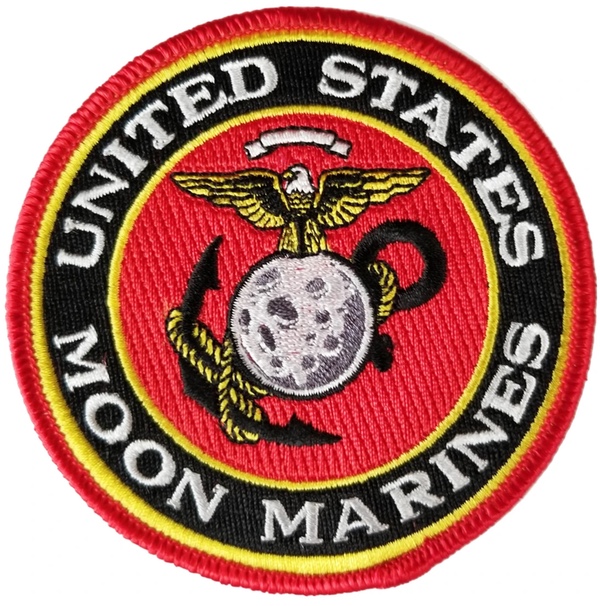 In the show, a squad of “Moon Marines,” including a woman, is sent to Jamestown for protection. (credit: AppleTV+) |
Emily:
I was intrigued by the show allowing John Lennon to survive an assassination attempt. It’s not a major plot point during season two, but I loved how the show allowed Lennon to become a sort of humorous talking head and pop culture force promoting peace during the Reagan years. When Ellen Waverly Wilson and Larry Wilson are eating breakfast during one scene, I love how Lennon was on morning television joking about Ronald and Nancy’s love life, as you know he would’ve done during the 1980s had he lived.
I really loved the little pop culture moments, such as a newly married, freshly permed Tracy Stevens appearing on “The Tonight Show” with Johnny Carson. This scene showed how Carson was (true to real life) obsessed with space, and how Tracy was taking back her power following a long spaceflight hiatus and a divorce from her famous astronaut ex-husband, even though at times she was taking back her power in a flawed way by drinking and partying way too much. It also shows how, in this reality, astronauts were still considered “celebrities”—during the 1980s in NASA’s actual timeline, save for pioneers such as Guy Bluford and Sally Ride, many post-Apollo astronauts were probably not recognized publicly outside of, say, space-themed events.
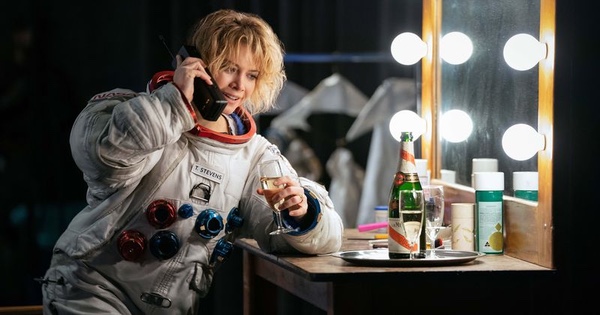 Tracy Stevens enjoys the high life as an astronaut celebrity before returning to space. (credit: AppleTV+) |
Dwayne:
Anybody under 50 is probably not really going to understand the Johnny Carson thing. They might know that he was a famous late-night talk show host, but they’re not going to realize that he was a cultural juggernaut. Today we have multiple late shows, and of course the Internet, so nobody looms large. But back then, Johnny Carson was it. If you appeared on Carson, the next morning people would recognize you on the street.
| An interesting thing to think about with “For All Mankind” is what happens with the earlier heroes like Shepard and John Glenn if an extended space program provides a lot of additional ones, like Molly Cobb and Tracy Stevens. |
I've written before about how I think that the first season offers some interesting insights about history. (See: “It is very cold in space: Season 2 of ‘For All Mankind,’” The Space Review, February 8, 2021, and “In the paler moonlight: the future’s past in ‘For All Mankind,” The Space Review, October 12, 2020, and, “Wasn’t the future wonderful? For All Mankind and the space program we didn’t get,” The Space Review, March 9, 2020.) Using the counterfactual or alternative history approach can be entertaining, but it also can be used to question assumptions, to challenge the deterministic approach to history that assumes that everything had to happen the way it happened. There are many examples in actual history where historians have noted that if just one thing had changed, the larger course of historical events could have been much different. A classic example is the fog bank that shielded George Washington's escape from the city of New York early in the Revolutionary War—if that fog had rolled in ten minutes later, Washington would have been captured by the British.
Emily:
As a big Skylab fan, I was also really excited how the space station was used during the 1980s at the opening of season two. It appeared to be a later version of Skylab (Skylab B?), because it looked remarkably intact. I’ve talked to a few astronauts from the Skylab era who were disappointed Skylab B didn’t fly and were equally disappointed the first space station yielded only three missions before it was vacated, then allowed to fall back to Earth in July 1979.
I’ve often wondered if NASA had the budget and had allowed the Apollo Applications Program to have more missions, would we have advanced further in space stations, space physiology, and other scientific areas? Would technology on Earth have advanced more quickly because of innovations in space during the 1970s? Also, would astronauts who resigned during the early 1970s due to a lack of flights have stayed, and enjoyed long careers? During that time, astronaut-scientists including Philip Chapman—who would’ve been the first Australian-born astronaut—and Donald Holmquest, resigned due to a lack of scientific focus within NASA, and a lack of flights.
It makes me wonder about what type of space stations we might see in season three (perhaps a more sophisticated station by Mars?),and would we have had a more “For All Mankind”-esque reality if these programs had kept flying throughout the 1970s.
Dwayne:
I loved seeing Skylab there with a shuttle attached. I wish we had seen more of it in the show. Many years ago, Tom Frieling wrote an excellent article about Skylab B. Frieling was a big fan of Skylab B, but when he dug into the subject, he concluded that it never would have worked, you couldn’t get from point A to point B, so to speak, given NASA’s existing budget, resources, infrastructure, and plans. Launching the extra workshop would have required a Saturn V, plus additional Apollo spacecraft, plus all the ground infrastructure like the VAB and the launch pads. NASA was converting to the shuttle and needed to start modifying those things. Even with extra money, it would have had an impact on the shuttle program.
But there’s another aspect that’s hard to reconcile, which is that extended life science research was not a NASA goal in that decade or later, so in some ways the hardware was beside the point. What would NASA have done on an extended Skylab B mission? They were already planning on doing more life sciences on shuttle Spacelab missions. So where was the point where the life sciences program needed to transition? Did NASA need long missions involving three people, or did they need to start flying a lot more people on admittedly shorter shuttle missions?
When I worked on the Columbia Accident Investigation, I wrote the small section of the report on why NASA flew the STS-107 mission. That mission came about because NASA had suspended shuttle life sciences flights in the late 1990s, planning on shifting that research to the International Space Station. Then the gap became larger and larger. Transition periods between programs are always messy, and it is common to have to shelve major investments and throw away useable hardware in order to start on new goals.
Emily:
If you pause and look at Ed Baldwin’s astronaut assignment board, you also see a lot of familiar NASA faces mixed in with newer astronaut candidates: for example, Apollo-era astronauts such as Ron Evans, Paul Weitz, Alan Shepard, and Jim Irwin are on the board, among a few others. This also suggests another tantalizing what-if: if NASA had somehow integrated a dedicated lunar program and Skylab into their 1980s vision alongside the shuttle, would these astronauts have had even longer careers, and would a career like John Young’s not have been seen as an outlier?
Dwayne:
You know, for a long time there has been a hero worship culture around the early astronauts. I know that you’re familiar with this. An interesting thing to think about with “For All Mankind” is what happens with the earlier heroes like Shepard and John Glenn if an extended space program provides a lot of additional ones, like Molly Cobb and Tracy Stevens. Of course, they would become icons for American women and girls, but they also would have pulled attention from the earlier astronauts, and Shepard and Glenn would probably have seen their fame fade over time.
| The scene where Danielle Poole is confronted by her sister-in-law to me is the fulcrum of the entire second season. |
For me, there were several great scenes in the second season that I thought were really well-done, although they were not always connected to the spaceflight aspects of the show. In an early episode we saw Ed blow up at his daughter when he learned that she wanted to go to Annapolis. Normally, we'd expect him to be proud, but instead it triggers his fear and grief over his son's death nearly a decade earlier when Ed was on the Moon during his son's fatal accident. I thought that was a great bit of writing and an even better bit of acting from all three characters. Ed felt tremendous guilt for not being there, and he had spent the last decade on the ground because he thought he could protect his family that way.
Another great scene was when Danielle meets with her sister-in-law who points out that despite her success, Danielle is still a black woman taking orders from white people; she's not a commander. It gives Danielle the impetus to go confront Ed and demand she be put in command. I liked the contrast there, because as much as I liked Danielle, who had made some big sacrifices in her life, her sister-in-law was right, that if she did not demand power, nobody would ever give it to her. That harks back to our earlier comment about women astronauts in the American space program—they were rejected in 1962 and it took another 20 years for Sally Ride to fly. If Danielle would have simply waited for her turn, maybe she would be made commander by 2003, just like how it took American women two decades to get into space, huh?
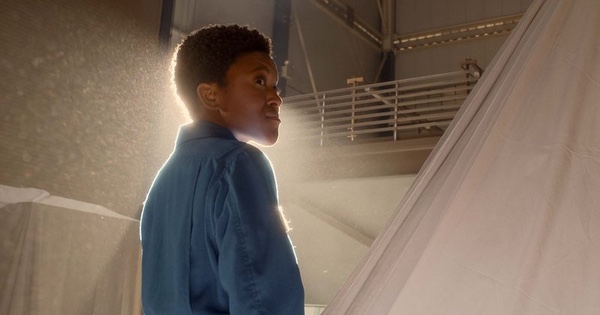 Danielle Poole visits her Apollo 22 spacecraft. (credit: AppleTV+) |
Emily:
The scene where Danielle Poole is confronted by her sister-in-law to me is the fulcrum of the entire second season. At the time Danielle is angered by her sister-in-law’s blunt words, but she begins to realize they were correct. She starts to see that she sacrificed her career for men, and on the lunar surface, nearly ended her career to save a white man’s reputation. I think there’s a point in many women’s lives and careers, especially if you’re in a male-dominated field, when you realize if you don’t fight for yourself and your dreams, nobody else will fight for them—it’s all up to you. She was in danger of becoming a “mascot.” So, she goes to Ed Baldwin, the most powerful astronaut at NASA, and challenges him to give her a command. And then we see Danielle becoming the leader she always knew she could be and should’ve been. I can’t wait to see where she is in season three.
Dwayne:
And Danielle literally saved the world from nuclear annihilation. Imagine if Ed had said no to her: everybody dies.
Another scene I really liked was when Aleida has to go and apologize to Bill Strausser, who quit after she brought up an embarrassing episode that happened to him 17 years earlier. Strausser explained that he had been working long hours in Mission Control during Gemini 8 when Neil Armstrong and Dave Scott had nearly died, and he had been so elated when they survived. It was a case where he had been so proud to be part of that team, and then had it become embarrassing to him. It gave him incredible depth—here was a guy who was totally committed to his job, and with a petty insult she had just ripped that away from him. And then she confessed how she had been forced to live on the street and eat out of dumpsters and had been shot and was so terrified of going to jail that she didn't go to the hospital. That scene worked on so many levels, because to some extent we the audience were led to dislike these characters—Bill’s a bit of a jerk, and Aleida is self-destructive—and then we were reminded that both of them had their frailties, and yet both of them loved spaceflight so much that they fought to get where they are. One of the insights the writers had is that people who work in spaceflight are often really committed, they're pursuing a cause, a dream, a vision.
Emily:
The lead up to the emotional scene when Aleida discusses her past is also beautifully written. I love how she is geeking out seeing his rocket models. Many other women would’ve just thought, okay, this dude is a real nerd, but she knew better. This scene could have been really heavy-handed and cheesy (“They have differences but by golly, they’ll work them out together”), but at the beginning of the scene, they are shown as equals by that detail of geeking out over model rockets. It illustrates to me how we can come from very different backgrounds as people, but the love of spaceflight unifies.
Dwayne:
But despite those great scenes in season two, we also had Karen sleeping with Danny. If you do the math, she's more than 30 years older than him.
Emily:
I am trying to sort out that story line. There were a few things that mystified me during the second season, and that story line is one of them. I’m not entirely sure what a woman in her late 40s would get out of a relationship with a teenager; also, she has essentially wrecked her marriage over it. I’m hoping we learn more about what that was all about in season three. I also wish there was a better explanation of how the non-Pathfinder space shuttles made it to the Moon and back, but I suspended my disbelief to enjoy the show and the nice graphics.
Going back to discussing how alternate histories can serve as a “what if” about actual history, it looked to me as if the “For All Mankind” shuttle program better resembled the shuttle program we were sold during the 1970s, versus the one we actually got. During the 1970s, NASA was selling the shuttle as a routine ride to space, with flights every two weeks; there were supposed to be 500 flights by 1992. The early shuttle schedule circa 1978 still looks fantastic and daft in equal measures. But in “For All Mankind,” NASA seems to have the budget and the workforce to make this shuttle program more of a reality. And, of course, there are nuclear resources in spaceflight, such as the reactor at Jamestown and the NERVA engine on Pathfinder, which would’ve been very costly.
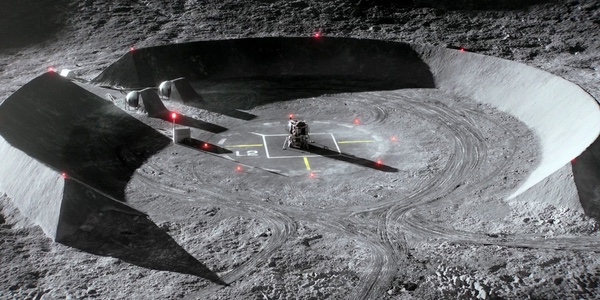 “For All Mankind” is probably the most realistic near-term spaceflight drama ever produced. The Jamestown base in the show has been in operation for nearly a decade and supports up to two dozen people. (credit: AppleTV+) |
Dwayne:
I had some other problems with the show besides the Karen-Danny thing, which I think made no sense at all (the psychological implications of that are kinda icky—was Danny a surrogate for her dead son? What’s the mirror image of an Oedipal Complex?) If season three is set ten years in the future, I’m not sure we’re going to get an explanation for the Karen-Danny thing, and it struck me as such a random development—like the writers pulled an option out of a hat—that maybe there’s no good explanation. I was also a bit disappointed by it too, because we previously had scenes that indicated that the Baldwins were a solid family. The head of the astronaut office still made time to have spaghetti dinner with his wife and daughter. They seemed strong, even with Ed’s breakdown about the daughter going into the Navy. It was like the cliché that appeared in a lot of TV shows and movies over a decade ago of having a character suddenly get hit by a bus. Yeah, it’s a shock, but it’s also lazy writing.
| It does hearken back to one of the show’s themes, which is the power of spaceflight to inspire and to change people and even society. It certainly did that. |
A more minor thing that bugged me is that it is implied that the second nuclear reactor at Jamestown base is for the production of nuclear weapons. That makes no sense at all, especially when you consider all the additional processing that has to happen to turn weapons-grade plutonium into a nuke. The comment about it was ambiguous, however, so I’m willing to accept that maybe the reactor was there for some other unstated purpose. I also didn’t like sending the shuttles to the Moon, or having Pathfinder be nuclear. In the early 1970s, NASA looked at options for sending humans to the Moon using a tug that would run back and forth between Earth and Moon, getting people and supplies from low Earth orbit shuttle flights, so the realistic option was out there on the Internet. But producer Ronald D. Moore wanted the shuttles because they’re so iconic, and didn’t have the money to spend on an additional spacecraft interior set. I wasn’t thrilled about that, but I can live with it.
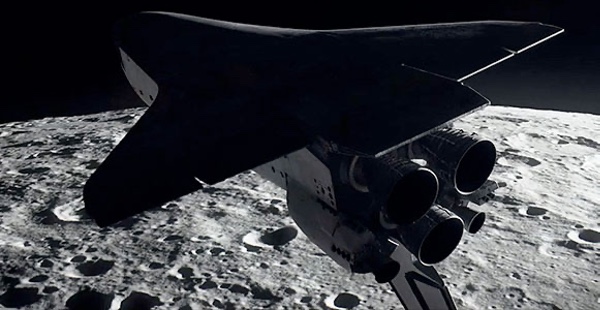 One of the show's conceits is that instead of using an Earth-Moon transport, space shuttles are refueled in low Earth orbit before heading to the Moon. This was done both because of the shuttle's iconic status, and budgetary reasons to save money on an additional film set. (credit: AppleTV+) |
I loved Danny's little monologue quoting James T. Kirk from an episode of “Star Trek”: “We can admit that we’re killers, but we’re not going to kill today.” “Star Trek” inspired so many people in the American space program, even during the Apollo era. And that little speech essentially inspires her to defy orders and ultimately save the planet: we can decide not to kill today.
But I was left a bit uneasy about the final episode and I don’t know why. I know what they were trying to do, showing the world starting to come apart, and multiple storylines converge, and everything coming to a head in orbit around the Moon, with space being the ultimate factor in the fate of humanity. Maybe it was because of the editing, or maybe it was because I’ve done a lot of research about the Cuban Missile Crisis and I’m stuck on that, but for some reason that didn’t work for me. It just seemed off. It was contrived, but worse: it felt contrived.
But it does hearken back to one of the show’s themes, which is the power of spaceflight to inspire and to change people and even society. It certainly did that. They’re filming season three now; no release date, but we probably won’t get to watch it until early next year. I’ll have to renew my Apple TV+ subscription.
Emily:
At the end of season two, we get a little teaser about season three with a boot touching the surface of Mars. I am assuming that Ellen Waverly Wilson (not sure if next season she’ll still be married? I guess we’ll find out) is still the NASA Administrator, and her focus on Mars paid off. But I’m curious as to whether the boot is Russian or American. Also, does the Soviet Union fall in this timeline, and does the United States ultimately collaborate with Russia, like we did with Shuttle-Mir and the ongoing International Space Station? Are we uneasy “friends” after the Apollo-Soyuz triumph?
More about Ellen Waverly Wilson: I am wondering if perhaps society and the law also catches up in recognizing the LGBTQ population during the 1990s. Sally Ride is a figure in the “For All Mankind” universe. Perhaps Ride’s changes in her personal life inspires Ellen to face her own reality during the next decade, and to more convincingly pursue her own relationship needs and desires.
I’m sort of wondering if they’re going to depict an Out of the Present-type scenario, in which a cosmonaut goes to space Soviet, but comes back to an entirely different country—this time more than a year later. (Out of the Present was a 1995 documentary film by Andrei Ujică that depicts cosmonaut Sergei Krikalev’s ten-month stay in space, against the backdrop of the collapse of the Soviet Union circa 1991–92.)
The end of the last season also saw Margo Madison, the head of Johnson Space Center, potentially getting pulled into a Soviet “honey trap,” being reconnoitered and pursued by the handsome Soviet engineer she collaborated with during the show’s Apollo Soyuz Test Project. So, I am wondering if the Cold War is still hot during the next season, and if Margo ends up in Leavenworth. I guess we’ll see...
Dwayne:
You know, that boot on Mars could be Chinese…
Note: we are using a new commenting system, which may require you to create a new account.
